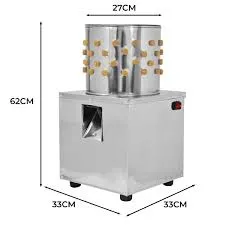vacuum airtight sealing packaging machine
Dec . 05, 2024 06:52 Back to list
vacuum airtight sealing packaging machine
Vacuum Airtight Sealing Packaging Machines Revolutionizing Food Preservation
In today’s fast-paced world, the food industry is continuously evolving, focusing on extending the shelf life of products while maintaining their quality. One significant advancement in this domain is the development of vacuum airtight sealing packaging machines. These innovative machines have transformed the way food is preserved, stored, and transported, ensuring that consumers receive products in optimal condition.
Understanding Vacuum Sealing
Vacuum sealing is a packaging method that removes air from the package before sealing it. This process is vital because air is one of the primary causes of food spoilage. By eliminating air, vacuum sealing drastically reduces the growth of aerobic bacteria and mold, thus prolonging the life of perishable items. It also helps in minimizing oxidation, which can lead to rancidity and loss of flavor, color, and nutritional value.
The Functionality of Vacuum Airtight Sealing Machines
Vacuum airtight sealing packaging machines operate by encasing food products in vacuum-sealed bags or containers. The machines work in several stages first, they remove the air from the packaging, and then they heat seal it to create an airtight environment. There are various types of vacuum sealing machines available, from small, countertop models designed for home kitchens to large, industrial machines capable of handling bulk packaging for commercial operations.
Types of Machines
1. Chamber Vacuum Sealers These are typically used in commercial environments. Food bags are placed inside a chamber, and the entire chamber is evacuated of air before sealing. This method is effective for liquid-heavy foods as it prevents any spillage during the sealing process.
2. External Vacuum Sealers These machines are more common for home use. They work by suctioning air from a bag that is placed within the machine. While they are generally more affordable, they may not be as proficient as chamber sealers for liquids or moist foods.
3. Industrial Vacuum Sealers Designed for high-volume operations, these machines come with advanced features and automation capabilities to accommodate large packaging tasks efficiently.
Benefits of Vacuum Airtight Sealing
vacuum airtight sealing packaging machine

The advantages of vacuum sealing are manifold, especially in food storage and preservation
- Extended Shelf Life Foods packed with vacuum sealing can last 3 to 5 times longer than those stored traditionally. This is particularly crucial for meat, fish, and vegetables.
- Flavor Retention Vacuum sealing helps retain the original flavor and moisture content of foods. This is essential for both culinary quality and consumer satisfaction.
- Cost Efficiency By extending shelf life and reducing spoilage, businesses can save on costs related to waste. Moreover, consumers can take advantage of bulk purchasing and storage.
- Space Saving Vacuum-sealed packages are more compact and can maximize storage space in both home and commercial refrigerators and freezers.
- Marination and Sous Vide Cooking Vacuum sealing is also beneficial for marinating foods quickly and conveniently. Additionally, it is integral to sous vide cooking, where food is sealed and cooked in a water bath at precise temperatures for optimal results.
Environmental Considerations
As the food industry moves towards sustainability, vacuum sealing can also play a role in reducing food waste. By enhancing food preservation, these machines can help minimize the large amounts of food typically discarded.
Conclusion
Vacuum airtight sealing packaging machines represent a significant leap forward in food preservation technology. Their ability to extend shelf life, retain flavor, and efficiently save space makes them indispensable in both domestic and commercial kitchens. As consumers become more aware of the benefits of food preservation and sustainability, the demand for vacuum sealing solutions is likely to increase. Embracing this technology not only enhances food safety and quality but also encourages a more responsible approach to food consumption. The future of food packaging and preservation seems bright, with vacuum sealing at the forefront of this transformative journey.
-
Hot Sale 24 & 18 Door Rabbit Cages - Premium Breeding Solutions
NewsJul.25,2025
-
Automatic Feeding Line System Pan Feeder Nipple Drinker - Anping County Yize Metal Products Co., Ltd.
NewsJul.21,2025
-
Automatic Feeding Line System Pan Feeder Nipple Drinker - Anping County Yize Metal Products Co., Ltd.
NewsJul.21,2025
-
Automatic Feeding Line System - Anping Yize | Precision & Nipple
NewsJul.21,2025
-
Automatic Feeding Line System - Anping Yize | Precision & Nipple
NewsJul.21,2025
-
Automatic Feeding Line System-Anping County Yize Metal Products Co., Ltd.|Efficient Feed Distribution&Customized Animal Farming Solutions
NewsJul.21,2025






